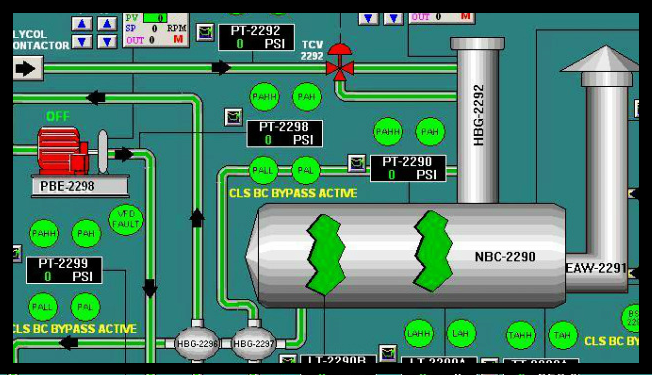Study the basic Difference between PLC, SCADA, HMI, RTU, DCS control systems used in industrial automation and control instrumentation.
PLC, SCADA, HMI, RTU, DCS

SCADA
SCADA = Supervisory Control And Data Acquisition - a control system that has the ability to control a PLC from a Supervisory standpoint. This means that the PLC contains the critical control logic and is able to operate completely independently.
The SCADA system is granted the power to manipulate setpoints, control modes, auto/manual functions, start/stop equipment, initiate/terminate program sequences, etc. SCADA systems also collect, store, and display live data (on an HMI).
The data is stored in a historian (such as PI) for troubleshooting and analysis of past events.
HMI
HMI = Human Machine Interface - A few examples are: a DCS graphic, a keypad connected to a VFD (Variable Frequency Drive), a keypad connected to a PLC, a graphical representation of a process that utilizes a mouse and/or touch screen to allow an operator to interact with an industrial automation system (of any kind).
Basically, anything that a human interacts with the manipulate, monitor, and edit a control system.
RTU
RTU = Remote Terminal Unit - Some people refer to PLCs as RTUs. The RTU itself is a microprocessor that processes I/O (input/output) that is connected to field electrical and instrumentation devices.
The data that is collected and the control that is put into action are generally connected to an upstream SCADA or DCS. Wikipedia has this covered very well:
DCS
DCS = Distributed Control System - an industrial control system that utilizes multiple controllers (processors) that are located at the lowest point within the system to ensure maximum uptime and stability during a communications or other failure.
The controllers can be in the same room, but are generally strategically placed all over an industrial facility to allow the I/O wiring from the instrumentation and electrical devices to be connected to it. The high-end DCS systems have two or more redundant controllers and communication networks (usually Ethernet) to ensure maximum uptime.
Only in the most critical processes will you find redundant I/O (Nuclear power plants are a great example of that). DCS are very flexible systems with the ability to handle extremely complicated process control programming.
Analog and digital signal processing and conditioning combined with advanced algorithms make DCS systems an extremely valuable tool in any industrial process. I have been in the wastewater field for 20 years and have also worked on the power and paper industries. DCS systems are the very core of our operations.
PLC
PLC = Programmable Logic Controller - smaller and slightly less powerful that a DCS system, a PLC is generally utilized in a small stand-alone process where a DCS is not needed.
Exceptions to this are vendor supplied control panels that are sold with mechanical equipment to perform vendor specified safety, startup, stopping, emergency stopping, process control within set limits, etc.
The automotive manufacturing industry is a huge user of PLCs. Many vendors will allow supervisory control over their PLCs, but will not allow their proprietary logic to be built within a DCS system.
We fight this and often win after sighing an NDA. PLCs can easily be integrated into a DCS as “third party” I/O and as I said above can be utilized in a SCADA system. There is a class of PLCs on the market that come close to the power of a DCS, they are the 5000 series from Rockwell Automation (Allen Bradley).
Although it may be possible with lots of effort, they still can’t easily contend with the redundant controller, network, power, etc. system like the Emerson Ovation DCS natively has (which is what I work with on a daily basis).
The DCS is far more expensive, but its longevity, upgradability, scalability, etc. are incredible. This is no way knocks Allen Bradley; we have several hundred of them installed as third-party I/O all over my organization.
I recommend reading the “ Automation Body of Knowledge ” which is the primary piece of study material that is used in the ISA-CAP (International Society of Automation - Certified Automation Professional) examination. Nothing replaces real-world experience, but that book is a great place to start.